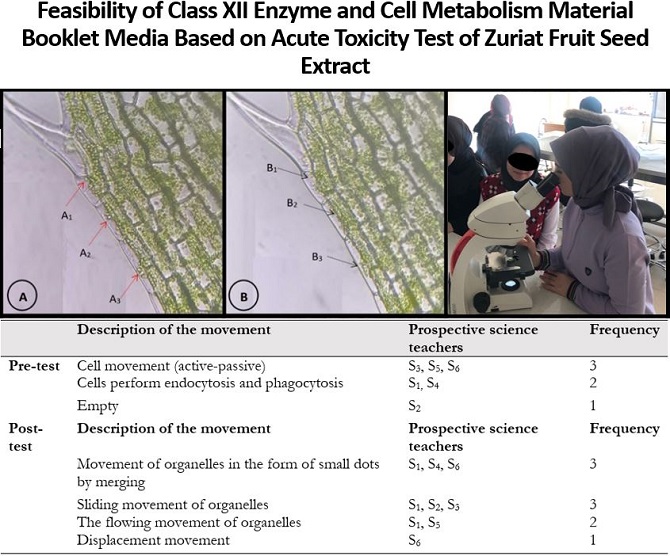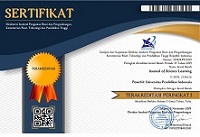
The use of Egeria densa in understanding the cellular movement at the micro level of prospective science teachers
Abstract
This study aims to help students learn cytoplasmic flow movement by using Egeria densa as a model. The study was conducted with six prospective science teachers studying at Bayburt University's Faculty of Education Science Teaching Undergraduate Program. As a data collection tool, a form containing questions to obtain prospective science teachers' knowledge of the concept of living things and the common characteristics of living things was used. The content analysis method was used to analyze the data. As a result of the findings, it was determined that although the prospective science teachers had sufficient knowledge about the vitality feature, they could not explain the movement, which has the vitality feature in detail. In addition, it was determined that the prospective science teachers could explain the cellular movement, which they had difficulty understanding at the micro level, by using Egeria densa as a model. Therefore, it can be said that using Egeria densa as a model for prospective science teachers to make sense of movement at a micro level is helpful.
Full Text:
Download PDFReferences
Adadan, E. (2013). Using multiple representations to promote grade 11 students‟ scientific understanding of the particle theory of matter. Research in Science Education, 43(3), 1079-1105.
Ayas, A. (2016). Concept teaching. In S. Çepni (Ed.), Science and technology teaching from theory to practice (13th Edition) (pp. 192-220). Ankara: Pegem Academy Publishing.
Babai, R., Sekal, R., & Stavy, R. (2010). Persistence of the intuitive conception of living things in adolescence. Journal of Science Education and Technology, 19, 20-26.
Bahar, M. (2003). A study of pupils’ ideas about the concept of life. Kastamonu Eğitim Dergisi,11(1), 93-104.
Bahar, M., Cihangir, S., & Gözün, Ö. (2002, Eylül). Alternative thought patterns of pre-school and primary school students about living and non-living objects. V. National Science and Mathematics Education Congress, ODTÜ, Ankara.
Brenner, E.D. (2017). Smartphones for teaching plant movement. The American Biology Teacher, 79(9), 740-745.
Büyüköztürk, Ş., Kılıç-Çakmak, E., Akgün, Ö.A., Karadeniz, Ş., &
Demirel, F. (2014). Scientific research methods (16th Edition). Ankara: Pegem Academy Publishing.
Dalkılıç, Z. (2020). Movement, behaviour and intelligence in plants. Journal of Adnan Menderes University Agricultural Faculty, 17(2), 295-301.
Demirci, B. (2017). Science education policy. In M.P. Demirci Güler, (Ed.), Science teaching (pp. 1-7), Ankara: Pegem Academy Publishing.
Dubeck, L.W., Boss, J.E., & Moshier, S.E. (2004). fs of living things in Fantastic voyages. New York: Springer.
Frailich, M., Kesner, M., & Hofstein, A. (2009). Enhancing students‟ understanding of the concept of chemical bonding by using activities provided on an interactive website. Journal of Research in Science Teaching, 46(3), 289–310.
Gallegos-Cázares, L., García-Rivera, B., Flores-Camacho, F., & Calderón-Canales, E. (2016). Models of living and non-living beings among indigenous community children. Review of Science, Mathematics and ICT Education, 10(2), 5-27.
Haigh, M., France, B., & Gounder, R. (2011). Compounding confusion? When illustrative practical work falls short of its purpose-A case study. Research in Science Education, 42(5), 967-984.
Hastürk, H. G. (2017). Fen öğretiminde alternatif ölçme-değerlendirme teknikleri. HG Hastürk. Teoriden pratiğe fen bilimleri öğretimi, 498-543.
Hofer, B.K., & Pintrich, P.R. (1997). The development of epistemological theories: Beliefs about knowledge and knowing and their relation to learning. Review of Educational Research, 67(1), 88-140.
İşbirliği, F. O. (1998). YÖK Dünya Bankası Milli Eğitim Geliştirme Projesi. Hizmet Öncesi Öğretmen Eğitimi. Ankara.
Johnson, B., & Christensen, L. (2014). Educational research: Quantitative, qualitative and mixed research (4th Edition). (Trans. S.B. Demir). Ankara: Educational Book.
Kılıç, Z., Atasoy, B., Tertemiz, N., Şeren, M., & Ercan, L. (2001). Subject area textbook review guide. Ankara: Nobel Publishing.
Kurt, H. (2013). Biology student teachers' cognitive structure about "Living thing". Educational Research and Reviews, 8(12), 871-880.
Kwon, Y. R. (2003). Exploring Korean young children’s ideas about living things (Doctoral dissertation). Pennsylvania State University, Pennsylvania, USA.
Lankford, D., & Friedrichsen, P. (2012). Red onions, Elodea, or decalcified chicken eggs? Selecting & sequencing representations for teaching diffusion & osmosis. The American Biology Teacher, 74(6), 392-399.
Martínez-Losada, C., García-Barros, S., & Garrido, M. (2014). How children characterise living beings and the activities in which they engage. Journal of Biological Education 48(4), 201-210.
McMillan, J.H., & Schumacher, S. (2010). Research in education: Evidence-based inquiry (7th ed.). New York: Pearson Publishing.
Miles, M.B., & Huberman, A.M. (1994). Qualitative data analysis: An expanded sourcebook (Second edition). California: SAGE Publications.
Mortimer, E., & Scott, P. (2003). Meaning making in secondary science classroomsaa. UK: McGraw-Hill Education.
Mumba, F., Chabalengula, V.M., & Banda A. (2014). Comparing male and female pre-service teachers„ understanding of the particulate nature of matter. Journal of Baltic Science Education, 13(6), 821-827.
Münkel-Jiménez, M., Bonilla-Araya, M., Grey-Pérez, A. D., & Herrera-Sancho, O. A. (2019). Awaking interest in science learning: Hands-on photosynthesis demonstrations using Elodea canadensis and Spinacia oleracea. Journal of Chemical Education, 97(2), 457-461.
Opfer, J.E., & Siegler R.S. (2004). Revisiting preschoolers living things concept: A microgenetic analysis of conceptual change in basic biology. Cognitive Psychology, 49(4), 301-332.
Öztürk, B. (2017). Implementation of cooperative learning assisted with the models and seven principles for good practice in education in the teaching of particulate nature of matter (Doctoral dissertation). Atatürk University, Erzurum.
Selvi, M., & Öztürk-Çosan, A. (2018). The effect of using educational games in teaching kingdoms of living things. Universal Journal of Educational Research, 6(9), 2019-2028.
Shimmen, T. (2007). The sliding theory of cytoplasmic streaming: Fifty years of progress. Journal of Plant Research, 120, 31-43.
Shmaefsky, B.R. (2004). Using elodea as a live model of the eukaryotic cell. Journal of College Science Teaching, 33(3), 52-55.
Stoica, D., Miron, C., Jipa, Al., & Popescu, M.V. (2016). The study of some thermal phenomenon by computer-assisted experiments and mbls. Romanian Reports in Physics, 68(1), 425-439.
Su, T., Cheng, M.T., & Lin, S.H. (2014). Investigating the effectiveness of an educational card game for learning how human immunology is regulated. CBE-Life Sciences Education, 13(3), 504-515.
Tamir, P., Gal-Choppin, R., & Nussinovitz, R. (1981). How do intermediate and junior high schools students conceptualize living and non-living?. Journal of Research in Science Teaching, 18, 241-248.
Tominaga, M., & Ito, K. (2015). The molecular mechanism and physiological role of cytoplasmic streaming. Current Opinion in Plant Biology, 27, 104-110.
Torres-Porras, J., & Alcántara-Manzanares, J. (2021). Are plants living beings? Biases in the interpretation of landscape features by pre-service teachers. Journal of Biological Education, 55(2), 128-138.
Treagust, D.F. (1998). Development and use of diagnostic tests to evaluate students‘ misconception in science. International Journal of Science Education, 10(2), 159-169.
Ülgen, G. (2004). Concept development. Ankara: Nobel Publishing.
Uno, G.E. (2009). Botanical literacy: What and how should students learn about plants? American Journal of Botany, 96, 1753-1759.
Verchot-Lubicz, J., & Goldstein, R.E. (2010). Cytoplasmic streaming enables the distribution of molecules and vesicles in large plant cells. Protoplasma, 240, 99-107.
Vondrasek, J.R. (2013). Osmosis, lab math, & microscopes: An inquiry based approach for reviewing basic lab skills and concepts while investigating plasmolysis in Elodea cells. Proceedings of the Association for Biology Laboratory Education, 34, 397-404.
Wandersee J.H., Mintzes J.J., & Novak J.D. (1994). Research on alternative conceptions in science. In Gabel DL (Ed.), Handbook of research on science teaching and learning. New York: Simon & Schuster and Prentice Hall International.
Wandersee, J., & Schussler, E. (1999). Preventing plant blindness. American Biology Teacher, 61, 82-86.
Yılmaz, Ş., Timur, B., & Timur, S. (2017). Determining secondary school students’ keywords about the “living being” concept: A phenomenology study. Journal of Theory and Practice in Education, 13(4), 659-669.
DOI: https://doi.org/10.17509/jsl.v7i1.63818
Refbacks
- There are currently no refbacks.
Copyright (c) 2024 Abdurrahman Sefalı, Bilge Öztürk

This work is licensed under a Creative Commons Attribution-ShareAlike 4.0 International License.


Jl. Dr. Setiabudhi 229 Bandung 40154, West Java, Indonesia











